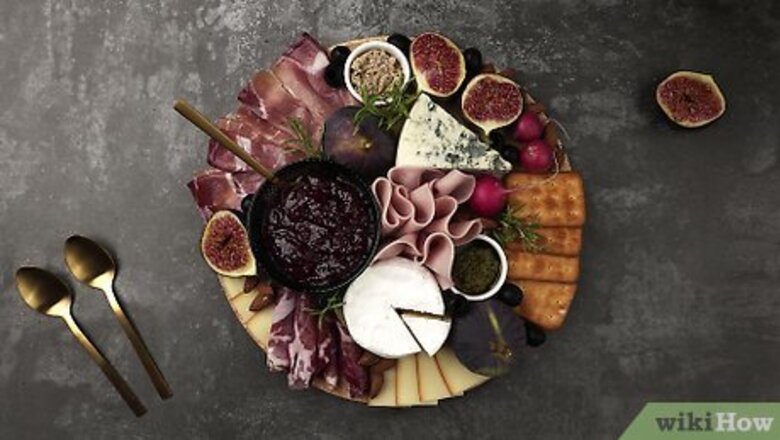
views
Choose a theme to make your planning easier.
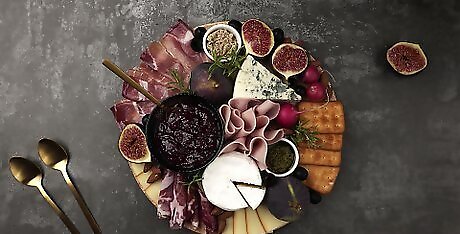
A theme isn’t totally necessary, but it can help! If you’re at a loss as to what to add to your charcuterie board, try picking out a theme based on the nearest holiday or a flavor profile. Then, you can choose ingredients that fit into that theme for a fun, easy way to fill out your board. Don’t be afraid to get creative with it, and feel free to make up your own theme, too. For example: Halloween charcuterie board (filled with deviled eggs, ghost-shaped pastries, and mini pumpkins) Thanksgiving charcuterie board (made with sliced turkey, roasted potatoes, and tons of veggies) Sweet and salty charcuterie board (filled with salty pretzels, crackers, and cheeses, paired with jams, jellies, and mints) Asian-inspired charcuterie board (made with chicken skewers, sugar snap peas, wasabi peas, and pineapple)
Pick a nice wooden platter.
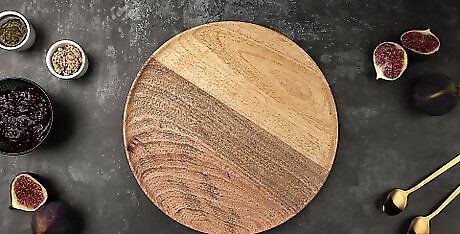
A wooden cutting board or cheese board is all you need. The size of your platter dictates how much food you’ll be serving on your charcuterie board, so be sure to take the size of your party into account. For larger parties, you might want to use a 20 by 30 in (51 by 76 cm); for smaller parties, a 10 by 14 in (25 by 36 cm) board will do. Many people use a nice wooden cutting board to display their charcuterie, since that’s generally what looks best. If you plan to put anything small on your board (like grapes or nuts), consider using a board with a lip around the edge so your items don’t roll away. If you don’t have a wooden board, don’t sweat it—a wooden cutting board is traditionally what’s used for charcuterie boards, but you can also use a plastic or metal serving tray. Just make sure it’s something you can cut on, since you and your guest might be slicing cheese or meats.
Select 2 to 3 cheeses.
The cheese is the main focal point, and you have a lot of options. Go for a variety of cheeses with different flavors and textures so your guests have a range to choose from. In general, experts recommend picking 2 hard cheeses and 1 soft cheese, with 2 to 3 ounces of cheese per person. Place your cheeses on your board first, and spread them out so they take up the most room. Slice a few pieces of cheese and create a small pile, but put the rest of the block of cheese on the board so guests can cut more if they want to. Good cheese to choose from include: Brie (soft) Sharp cheddar cheese (hard) Parmesan (hard) Goat cheese (soft) Feta cheese (soft) Baby Swiss cheese (hard) Mozzarella (semi-soft) Gruyère (hard) Provolone (hard)
Add condiments or spreads in small dishes.
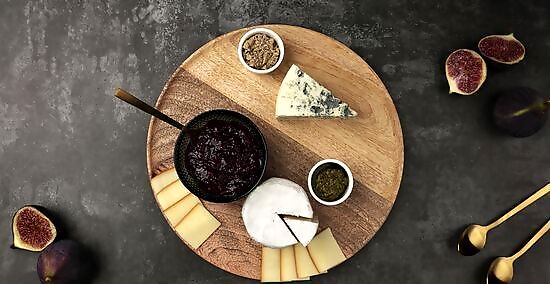
They’re a nice way to break up the color and texture. Fruit jams, honey, cheese dips, and mustard are all great options. Pour your condiments and spreads into small dishes, like ramekins, that will fit on your platter. Then, arrange them in between the large chunks of cheese, since they’re going to take up a lot of room. In general, try to have 1 to 2 tbsp (14 to 29 g) of condiments or spreads per person. It’s important to balance out your flavors, which is why using sweet jam or honey is always a good idea. The sweetness helps balance out the saltiness of the cheese and meat, and it can be a nice break for your palette as you snack.
Add a few small knives.
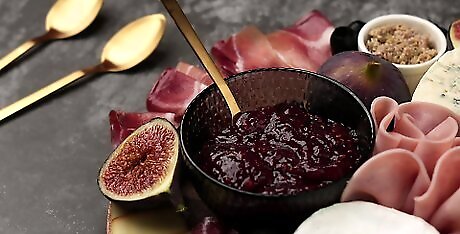
Your condiments are going to need a spreading knife. Insert a few small, flat knives next to each spread or condiment you have on your board. That way, your guests won’t need to dip anything with their hands, and they’ll feel confident in eating anything that’s in front of them. You can also add a few small cheese knives so guests can slice cheese on their own.
Pick out a few cured meats.
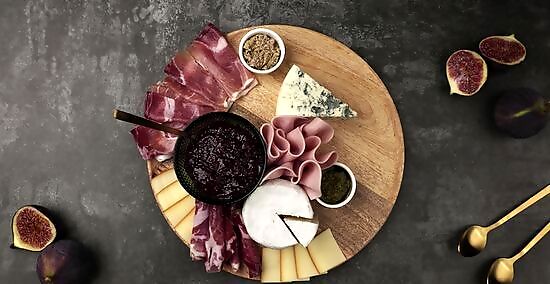
Meat is another area that’s really up to preference. Head to the deli section of your grocery store and take a look at the pre-sliced cured meats. Prosciutto, cured salami, pâté, boudin, and even ham make great finger foods for your board. If your meat isn’t pre-sliced, cut it into small, bite-sized pieces, then arrange it in piles in between your cheeses and your condiments. If you don’t want to shell out a ton of money for meat, find a variety pack of charcuterie instead. It will provide a ton of options and different flavors of meat for you and your guests to enjoy. If you or your guests are vegetarian, skip the meat entirely. You can still make a charcuterie board without meat.
Find some mild, mellow crackers.
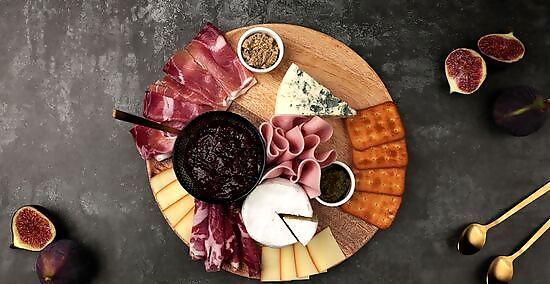
Your crackers should be vessels for other foods. When you’re at the store, grab some plain, mild crackers that don’t have a ton of flavor. If crackers aren’t your thing, you could also grab a baguette and slice it into bite-sized pieces. Once you have your crackers or bread, arrange them in piles in between your meats, cheeses, and condiments. For a gluten-free option, put out some sliced veggies, like carrots and celery.
Grab some fresh fruit.
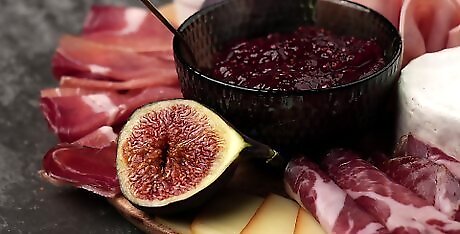
Check out what’s in season at your local farmer’s market. Grab some fruit that’s easy to eat, like figs, apples, grapes, or melon. If it needs to be sliced, cut it up into bite-sized pieces so your guests don’t have any issues. You don’t have to offer a ton of fruit (it’s not really the star of the show), but make sure you have enough so that each guest gets a few pieces. Arrange your fruit in between what you already have, and don’t be afraid to nestle it into any open spaces. If you don’t have any fresh fruit on hand, dried fruit also pairs nicely with cheese and meat.
Contrast flavors with pickles or olives.
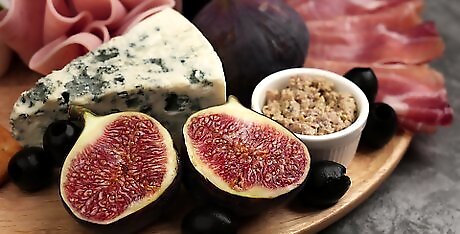
Balance out all those rich flavors with something mouth-watering. If you’d like to, provide your guests with something pickled or a dish of olives. The briny, sour flavors contrast nicely with the rich, salty taste of the meat and cheese. Plus, the colors contrast well with everything else on your board. If you aren’t a fan of plain pickles, try something else! Pickled beets, carrots, onions, or mushrooms make an interesting side dish on any charcuterie board.
Garnish with edible herbs.
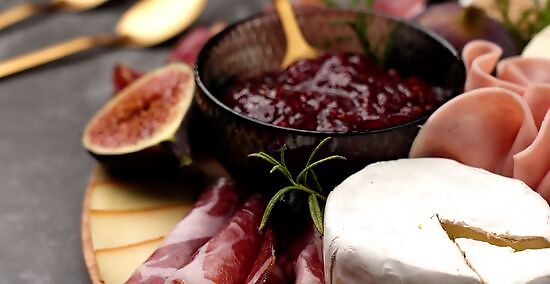
If your board is lacking a little texture, head to the herb garden. Chives, lavender, and oregano are all safe to have around food, and they can bring your charcuterie board to the next level. Sprinkle a few sprigs of herbs around your charcuterie board to wow your guests and make for a great photo-op. You could also try adding edible flowers, like pansies, roses, begonias, or impatiens.
Add texture and color with veggies.
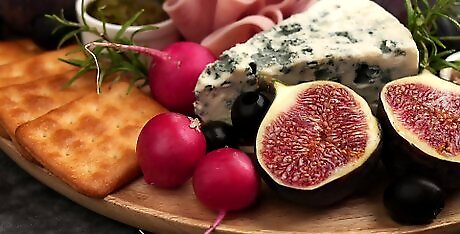
Is your board looking a little plain? Spruce it up with fun, bright vegetables, like purple cauliflower, yellow carrots, and watermelon radishes. Leave the leafy tops on any vegetables you have to give your board a fun blend of texture and flavor. Just make sure to warn your guests that they might not want to eat those leafy greens! If you have a farmer’s market nearby, try browsing for bright, fun veggies that look enticing.
Place your large centerpieces first.
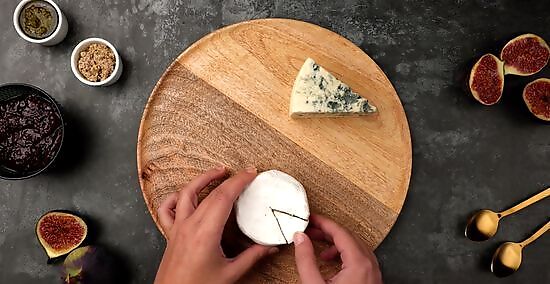
The big pieces of fruit or cheese will be the star of your board. Set those in the middle, and let them take up all the space that they need. This is a great way to start your board off, since you can arrange everything else around your centerpieces. If you’re using a large fruit, like a papaya or a pomegranate, make sure you peel and slice it so it’s easy for your guests to eat.
Add height variation with small containers.
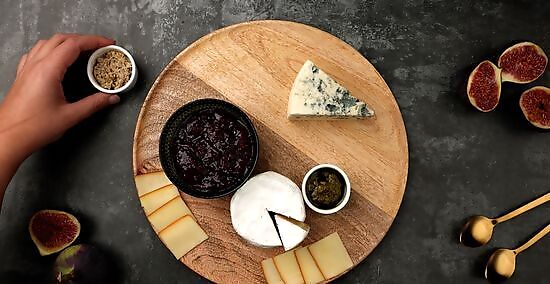
Little condiment dishes are a fun way to break up your board visually. Grab a few in varying heights and add them around your board to create different levels throughout. If any of your dishes are super tall, keep them near the back of the board so they don’t block any of the other ingredients. If you want your dishes to stand out, try using fun colors, like blue, green, or red. If you don’t have a ton of small dishes on-hand, head to your local thrift store to pick some out without breaking the bank.
Spread crackers and bread out in fans.
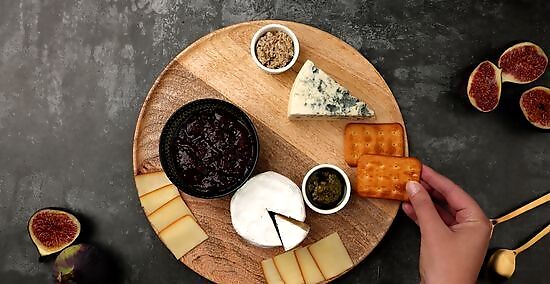
This is a fun, creative way to take up space. Instead of placing bread and crackers in a pile somewhere, spread them out so they’re in a fan formation. You can wrap them around the large piles of cheese or a big slice of fruit to fill up space and leave room for your guests to snack. You can do the same thing with flat slices of cheese if the piles are looking a little too plain!
Arrange the meat in creative ways.
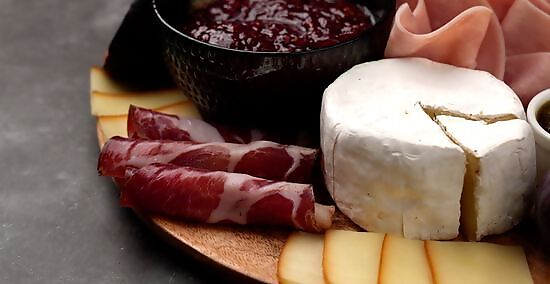
Make your sliced meat look as appealing as possible by placing it slice by slice. Instead of laying it flat on your charcuterie board, grab a piece of sliced meat and bunch it up so it almost looks like a rose. Then, place a few pieces of meat together on your board so they stand up like that. You can do this with thicker meats, like turkey and ham, so your guests can pick it up easily. If you’re using prosciutto, try to separate each slice before placing it on your board so it’s easier to grab. If your salami is very long, fold it in half.
Fill any gaps with nuts.
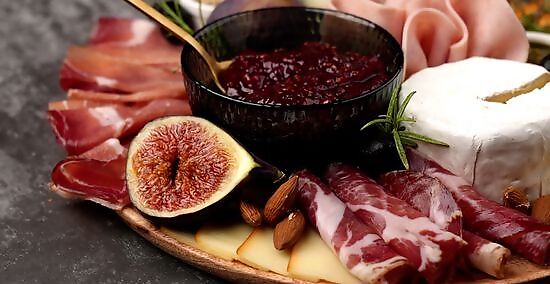
Your charcuterie board might still have a few gaps in it, and that’s okay. If you notice any bare spots, grab a handful of almonds, walnuts, or cashews to fill in the gaps and provide a salty snack for your guests. Stay away from anything with too much flavor that might overpower your board, like peanuts. Be sure to check in with your guests to make sure there aren’t any nut allergies. If there are, you can use ribbons of prosciutto or sliced fruit to cover empty spaces instead.


















Comments
0 comment